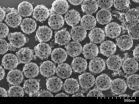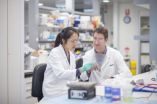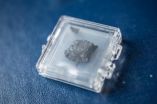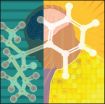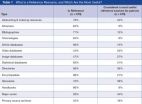(Press-News.org) Winter takes its toll on living things. To protect themselves from the elements, bears hibernate, and trees go dormant. Biologists have observed what happens when trees become dormant, but up to now, they haven't understood the underlying genetic mechanisms that enable them to start growing again.
Led by molecular geneticists from Michigan Technological University a gene has been identified and characterized that tells a poplar tree when winter ends and a spring growing season begins. Victor Busov, a professor in Michigan Tech's School of Forest Resources and Environmental Science; Yordan S. Yordanov, a research assistant professor at Michigan Tech; in collaboration with Cathleen Ma and Steven Strauss from Oregon State's Department of Forest Ecosystems and Society published their findings online in the Proceedings of the National Academy of Sciences (PNAS) this week.
They've named the gene—fittingly—"Early Bud-Break 1," since it helps awaken the plant cells responsible for growth from their winter sleep.
Using techniques of molecular genetics and genomics, the researchers modified the EBB1 gene to see what would happen when it is experimentally dialed up and down. They found that up-regulation of the gene accelerates new growth or bud-burst, while down-regulation of EBB1 delays bud-break, the name for the beginning of new growth. They also discovered that EBB1 is virtually undetectable while the tree is dormant but makes a dramatic reappearance just prior to and during bud-break.
"The absence of EBB1 during dormancy allows the tree to progress through the physiological, developmental and adaptive changes leading to dormancy," Busov explains, "while the expression of EBB1 in specific cell layers prior to bud-break enables reactivation of growth in the cells that develop into shoots and leaves and re-entry into the active growth phase of the tree."
Busov says the timing of the new growth after dormancy is environmentally and economically important, and its importance will grow as climate change escalates. "Late spring frosts can irreversibly damage the growing tissues, compromise growth vigor and make plants susceptible to insect damage," he explained. "If trees grow too early, they expose themselves to these dangers. If they start too late, precious growing time will be lost. The timing has to be exactly right. The wild swings and unpredictability of climate extremes makes nailing the exact timing very difficult.
"It is foreseeable that in the near future forest and fruit trees may need our help to cope with climate change," Busov went on to say. "The discovery of this gene is a small step in this direction. Scientists still have a long way to go to fully understand the process, but this discovery opens the door to an enigmatic world about which almost nothing was known. It can be used as a starting point for unraveling the mechanism behind it. By analyzing EBB1 and the physiological processes of which it is a part, it should be possible to gain new insights into control of dormancy release in perennial plants in general. This will enable novel approaches for population management, molecular breeding and genetic engineering of dormancy-associated traits."
INFORMATION:
The research was supported in part by grants from the US Department of Energy, the US Department of Agriculture and industrial members of the Tree Biosafety and Genomics Research Cooperative at Oregon State University.
How does a tree know it's time to grow again?
2014-06-17
ELSE PRESS RELEASES FROM THIS DATE:
Long-term study suggests ways to help children learn language and develop cognitive skills
2014-06-17
Examining factors such as how much children gesture at an early age may make it possible to identify and intervene with very young children at risk for delays in speech and cognitive development, according to a new study by researchers at the University of Chicago.
The research by leading early learning scientists looked at children from a wide variety of backgrounds, including those from advantaged and disadvantaged families, and those who had suffered brain injury. Their work was published in an article, "New Evidence About Language and Cognitive Development Based on ...
Nanoshell shields foreign enzymes used to starve cancer cells from immune system
2014-06-17
Nanoengineers at the University of California, San Diego have developed a nanoshell to protect foreign enzymes used to starve cancer cells as part of chemotherapy. Their work is featured on the June 2014 cover of the journal Nano Letters.
Enzymes are naturally smart machines that are responsible for many complex functions and chemical reactions in biology. However, despite their huge potential, their use in medicine has been limited by the immune system, which is designed to attack foreign intruders. For example, doctors have long relied on an enzyme called asparaginase ...
Gene 'switch' reverses cancer in common childhood leukaemia
2014-06-17
Melbourne researchers have shown a type of leukaemia can be successfully 'reversed' by coaxing the cancer cells back into normal development.
The discovery was made using a model of B-progenitor acute lymphoblastic leukaemia (B-ALL), the most common cancer affecting children.
Researchers from the Walter and Eliza Hall Institute showed that switching off a gene called Pax5 could cause cancer in a model of B-ALL, while restoring its function could 'cure' the disease.
Institute researchers Dr Ross Dickins and Ms Grace Liu led the study with institute colleagues and ...
E-cigs heavily marketed on Twitter, study finds
2014-06-17
E-cigarettes, also known as vaping pens or e-hookas, are commonly advertised on Twitter and the tweets often link to commercial websites promoting e-cig use, according to University of Illinois at Chicago researchers.
The study, published as a special supplement in the July 2014 issue of Tobacco Control released online June 16, has implications for future FDA regulations on the marketing of e-cigarettes and related products.
"There's this whole wild west of social media platforms – Facebook, Twitter and Instagram – and the FDA has no way to track what's happening in ...
Soft-drink tax worth its weight in lost kilos
2014-06-17
A tax on sweetened soft drinks could be an effective weapon in the war against obesity, generating weight losses of up to 3.64 kilograms as individuals reduce their consumption.
Researchers from Monash University, Imperial College London and University of York and Lancaster University, England have estimated the extent to which drinking habits would change if beverages such as carbonated non-diet soft drinks; cordials and fruit drinks were taxed.
Lead author Dr Anurag Sharma, of the Centre for Health Economics at Monash University, said such a tax could have important ...
Solar photons drive water off the moon
2014-06-17
Water is thought to be embedded in the moon's rocks or, if cold enough, "stuck" on their surfaces. It's predominantly found at the poles. But scientists probably won't find it intact on the sunlit side.
New research at the Georgia Institute of Technology indicates that ultraviolet photons emitted by the sun likely cause H2O molecules to either quickly desorb or break apart. The fragments of water may remain on the lunar surface, but the presence of useful amounts of water on the sunward side is not likely.
The Georgia Tech team built an ultra-high vacuum system that ...
Researchers identify new compound to treat depression
2014-06-17
There is new hope for people suffering from depression. Researchers have identified a compound, hydroxynorketamine (HNK), that may treat symptoms of depression just as effectively and rapidly as ketamine, without the unwanted side effects associated with the psychoactive drug, according to a study in the July issue of Anesthesiology, the official medical journal of the American Society of Anesthesiologists® (ASA®). Interestingly, use of HNK may also serve as a future therapeutic approach for treating neurodegenerative disorders such as Alzheimer's and Parkinson's diseases, ...
Surgical patients more likely to follow medication instructions
2014-06-17
A study in the July issue of Anesthesiology revealed that patients who receive a simple, multicolor, standardized medication instruction sheet before surgery are more likely to comply with their physician's instructions and experience a significantly shorter post-op stay in recovery. These findings are important because surgical patients often fail to follow their doctor's medication instructions for preexisting conditions such as diabetes and hypertension on the day they are having surgery – a costly mistake that can lead to surgery cancellation, complications and longer ...
References resources find their place among open access and Google, study finds
2014-06-17
Los Angeles, CA (June 17, 2014) How do open access sources, tightened budgets, and competition from popular technologies affect how librarians perceive and employ reference resources? How do librarians expect to utilize reference in the future? "The State of Reference Collections," a new SAGE white paper out today, finds that though the definition of reference is changing, this is in part because reference resources now look and feel like other information sources and because other information resources perform the traditional purpose of reference – answering research ...
Study links APC gene to learning and autistic-like disabilities
2014-06-17
BOSTON (June 17, 2014, 4:00 a.m. EDT) — Autistic-like behaviors and decreased cognitive ability may be associated with disruption of the function of the Adenomatous Polyposis Coli (APC) gene. When Tufts researchers deleted the gene from select neurons in the developing mouse brain, the mice showed reduced social behavior, increased repetitive behavior, and impaired learning and memory formation, similar to behaviors seen in individuals with autism and intellectual disabilities. This study is the first to evaluate how the loss of APC from nerve cells in the forebrain affects ...

